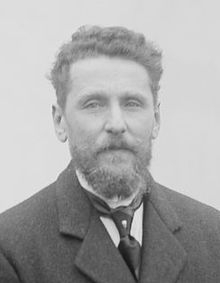Carlo Schanzer
 From Wikipedia the free encyclopedia
From Wikipedia the free encyclopedia

Carlo Schanzer (18 December 1865 – 23 October 1953) was a Vienna-born Italian jurist and politician. He held several cabinet posts from 1906 to 1922.
Early life and education
[edit]Schanzer was born in Vienna on 18 December 1865.[1] His father was a Polish-born business lawyer, and his mother was a pianist.[1] Schanzer had three siblings. His brother Ottone was a musicologist and composer and the other, Roberto, was an engineer and mathematician while his sister, Alice, married Tancredi Galimberti, a well-known poet and writer.[1] In the 1870s the family moved to Milan and then to Rome.[1]
After graduating from a high school in Rome Schanze received a bachelor's degree in law in November 1886.[1] In 1888 he obtained Italian citizenship.[1]
Career
[edit]Schanzer was a member of the Council of State and then became the director general of the civil administration at the Ministry of the Interior.[2] He was elected to the Italian Parliament in 1900 and to the Italian Senate in 1919.[2] He was appointed minister of posts to the third Giolitti cabinet[3] and was in office in the period 1906–1909.[2] He served as the minister of treasury and as the minister of finance in the first and second cabinets of Francesco Saverio Nitti between 1919 and 1920.[2] Schanzer was named as the minister of foreign affairs to the Facta cabinet on 25 February 1922.[4][5]
During the Fascist rule in Italy Schanzer continued his public activities and was appointed minister of state in December 1928.[1] Following the end of the Fascist period Carlo Sforza, high commissioner for the sanctions against fascism, proposed Schanzer's forfeiture on 7 August 1944 based on the verdict of the a higher court dated 21 October 1944.[1] Against the order Schanzer appealed to the Supreme Court of Cassation which annulled the forfeiture on 8 July 1948.[1]
Personal life and death
[edit]Schanzer published several articles in different academic journals, including Current History.[6] On 20 July 1899 he married Corinna Centurini with whom he had two daughters, Fulvia and Ludovica.[1]
He died in Rome on 23 October 1953.[1] His grandson was Carlo Ripa di Meana, an Italian politician and noble, who was the son of Fulvia.[7]
References
[edit]- ^ a b c d e f g h i j k "Schanzer, Carlo" (in Italian). Treccani. Retrieved 14 January 2022.
- ^ a b c d "Collana Storica Della Banca D'Italia Biografie" (PDF) (in Italian). Banca D'Italia (Editori Laterza). 1989. p. 344. Archived from the original (PDF) on 14 January 2022. Retrieved 14 January 2022.
- ^ Gabriele Balbi (2011). "The Origins of the Telephone in Italy, 1877–1915: Politics, Economics, Technology and Society". International Journal of Communication. 5: 1068. ISSN 1058-1081.
- ^ Aldo A. Mola. "Cronologia Sintetica Della Vita di Giovanni Giolitti". centrogiolittidronero.it (in Italian). Retrieved 14 January 2022.
- ^ "Italy's New Cabinet and the Fiume Episode". Current History. 16 (1): 168. April 1922. doi:10.1525/curh.1922.16.1.168. JSTOR 45329293. S2CID 249070830.
- ^ Carlo Schanzer (February 1924). "The New Accord between Spain and Italy". Current History. 19 (5): 730–735. doi:10.1525/curh.1924.19.5.730. JSTOR 45327427. S2CID 249081350.
- ^ "Addio a Carlo Ripa di Meana, due mesi fa la morte della moglie Marina". Today (in Italian). 2 March 2018. Retrieved 14 January 2022.
External links
[edit] Media related to Carlo Schanzer at Wikimedia Commons
Media related to Carlo Schanzer at Wikimedia Commons
